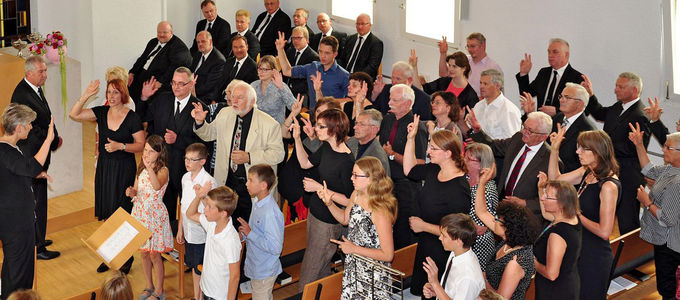
Using your body to speak: that is what sign language looks. Hearing impaired people can see what others can hear. In many New Apostolic congregations, divine services are also offered for the hearing impaired.
Felix Frobel (38) from Marburg is a special education teacher and one of the consultants for the New Apostolic Church’s work with the hearing impaired. For him, inclusion is not merely a word: “Divine services and pastoral care in sign language are an important step on the way to becoming an inclusive Church, ‘in which people feel at home’—even if they happen to be impaired.” Now there are even two hearing impaired Priests at work in Germany, says the enthusiastic minister. Together with many other volunteers, they work to create a barrier-free experience in all District Churches.
Supporting language with signs and gestures
Sign language is a completely independent visual language for the hearing impaired. There are several versions, including American, French, and even Chinese sign language, as well as German sign language, which in turn even features Berlin, Hamburg, Munich, and other dialect forms. It is visual because the speaker “draws” out the words—with his hands. When the hearing are interpreted into sign language, gestures accompany their speech. The spoken language is thus illustrated: what the hearing hear, the hearing impaired see through gestures and facial expressions. Sounds are made visible. This is all highly complicated. Gestures are clearly constructed by the shape and position of the hands, by the place of their execution, and by movement, and they are executed in accordance with firm rules. German Sign Language has a comprehensive lexicon and a highly differentiated grammar. Thus it can, in principle, accomplish the same things as any spoken language, and even articulate abstract concepts.
Central divine services for the hearing impaired
Divine services for the hearing impaired are scheduled in Lich and Hannover for the coming Sunday, and in Euskirchen, Zeulenroda, and Hamburg for the following Sunday. Such central divine services for the hearing impaired occur on a regular basis. In them, the sermon is interpreted into LBG, a kind of signed German (Sign-accompanied speech), and also simultaneously interpreted into “German Sign Language” (DGS).
Goals of the “Hearing Impaired” Work Group
New Apostolic divine services are now conducted with supporting signing in many congregations. This is in no small part thanks to a central Work Group that has taken on the challenge of creating such offers. The “Work Group for the Hearing Impaired” has existed since 2002. With the requisite professional skills and experience, its members work to develop the proper programming. The group convenes a meeting once each year. Its goals are obvious, namely to provide the Church’s leadership with information on the subject of pastoral care for the hearing impaired and to develop uniform documentation for the pastoral care of the hearing impaired. The group creates awareness of the needs of the hearing impaired and is committed to the improvement of communication.
Sign-language choir
Congregations thrive on participation—for this reason the divine services in all hearing-impaired congregations are enhanced by a sign-language choir. The hymn texts often sung in the New Apostolic Church are illustrated in sign language, either with or without musical accompaniment. In some places, a beautiful form of sign-poetry has come into being as a result.
A magazine by the name of “Echo” is currently being developed specifically for the hearing impaired by the editorial of North Rhine-Westphalia. The magazine has already appeared twice in publication and is also available for download on website.




